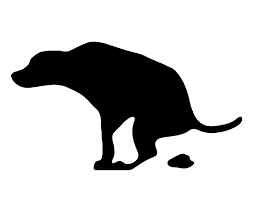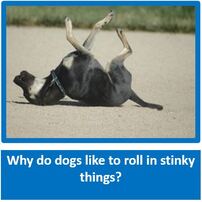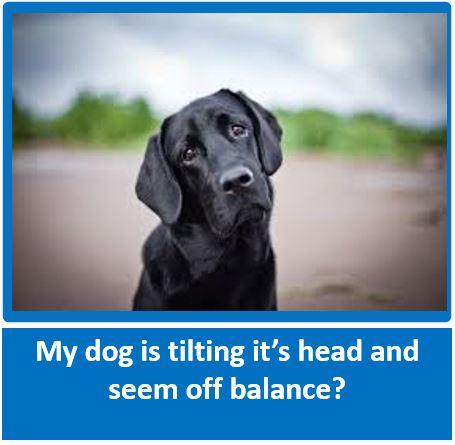Why Does my Dog Take So Long to Decide Where to Poop?
www.rover.com
(They have some really nice articles - do investigate when you have time - enjoy!)
www.rover.com
(They have some really nice articles - do investigate when you have time - enjoy!)

All dogs poop, but some take a lot longer to pick a spot than others. Does your dog have to sniff every fence post before pooping? It may surprise you to learn that there’s science behind her dawdling. If your dog takes a long time to decide where to poop, they’re not alone in the canine universe. From territorial strategy to the alignment of the earth’s magnetic poles, your dog has good reasons for taking her time.
So, why DO dogs take so long to decide on the perfect pooping spot? There are four main reasons: sniffing out other dogs' scents, anxiety, distractions,and, weirdly but truly, the magnetic poles.
Poop = Social Media for Dogs
We check each other’s status updates online—and hey, many of our pets have their own Instagram accounts.
But for dogs, it’s all about smells. Elimination (that is, poop and pee) is one of our dogs’ most nuanced and effective methods of communication. That’s why fire hydrants are so popular: they’re like the busy Facebook group of the dog world. Your dog’s chosen potty spot sends other dogs a message about where she’s been and what she’s been doing. When she sniffs around for a long time, she’s “reading” messages from other animals.
According to Carlo Siracusa, director of the Small Animal Behavior Service at the University of Pennsylvania veterinary hospital, “These messages can tell your dog how many other dogs are in the immediate area, the sexual status of those dogs…whether a particular dog is a friend or an enemy, what he or she had for lunch, and when they were last in the area” (source).
For some dogs, the “messages” encoded in scent secretions in other dogs’ waste serve as cues to make them go potty, too. That’s why your dog sometimes poops right next to another dog’s pile. (Perhaps this is a good time to remind you to always have poop bags handy!)
Performance and Location Anxiety
If your dog is nervous in other areas of life, she may be nervous about where she goes to the bathroom. Like humans, some dogs have a hard time going to the bathroom in “public” places. I know a dog who refuses to poop on walks but waits to take care of business in the corner of his backyard when he gets home. Some dogs need peace and quiet to get the job done. If your dog shies away from pooping in public, try walking her on empty streets, or during quieter times of the day.
Dogs can also develop surface preferences when they’re young. For instance, some pups prefer soft, grassy surfaces and won’t poop on bare dirt. Paper- or potty-pad-trained dogs may have a hard time transitioning to natural surfaces. My dog Ralph is a big fan of pooping in ivy and other overgrown plants. Whatever your dog’s preference, it may take them a while to find just the right spot.
How Magnetic Poles Affect Dog Poop
Does your dog spin around in a circle before assuming the poop position? You can thank the magnetic poles for that! It’s true: according to a study published in Frontiers in Zoology, dogs may prefer to excrete with their body aligned along the North-South axis.
Summarized in Wired magazine, the study observed dogs’ eliminating (both urination and defecation), and ruled out other influences such as time of day, the angle of the sun, and speed and strength of the wind. In the end, the scientists conducting the study were left with compelling evidence that the earth’s magnetic fields might influence how and where your dog drops a you-know-what.
Stop and Smell the Flowers (and THEN poop)
Magnetic fields, surface preferences, conditioned habit, and communication all have a strong influence on your dog’s pooping preferences. But sometimes, your dog is simply taking her sweet time because she likes being outside.
That’s right, your dog might be stalling on purpose! Dogs who only get outside access when it’s time to go potty learn that as soon as they go, they’ll be taken right back indoors. So they may sniff around, walk more slowly, and take their time choosing a place to poop in order to stay outside for longer.
You can help reverse this conditioning by making sure your dog gets plenty of fresh air without a time crunch. Work in a leisurely walk or yard romp that’s less about taking care of business and more about enjoying the great outdoors!
How to Help Your Dog Poop Faster
Now that you know why it takes your dog some time to choose the perfect pooping spot, you may have more patience waiting for her. But there are still times when you simply need your dog to poop in a hurry!
Training a specific potty cue can help train your dog to poop on command. Trainers often teach phrases like “hurry up” and “go potty” for this very purpose. The key is to be consistent and always reward your dog for successfully “going” on cue.
Of course, your dog needs to take her time to poop. The setting has to be just right. She may need to sniff, scratch, or spin around before heeding nature’s call.
Celebrating…Dog Poo?
The next time you feel impatient while your dog is deciding where to poop, remember: her complex biological systems are working together in a pretty amazing way to both eliminate waste and connect her to the larger world. When you think about it, dog poop is a beautiful thing!
So, why DO dogs take so long to decide on the perfect pooping spot? There are four main reasons: sniffing out other dogs' scents, anxiety, distractions,and, weirdly but truly, the magnetic poles.
Poop = Social Media for Dogs
We check each other’s status updates online—and hey, many of our pets have their own Instagram accounts.
But for dogs, it’s all about smells. Elimination (that is, poop and pee) is one of our dogs’ most nuanced and effective methods of communication. That’s why fire hydrants are so popular: they’re like the busy Facebook group of the dog world. Your dog’s chosen potty spot sends other dogs a message about where she’s been and what she’s been doing. When she sniffs around for a long time, she’s “reading” messages from other animals.
According to Carlo Siracusa, director of the Small Animal Behavior Service at the University of Pennsylvania veterinary hospital, “These messages can tell your dog how many other dogs are in the immediate area, the sexual status of those dogs…whether a particular dog is a friend or an enemy, what he or she had for lunch, and when they were last in the area” (source).
For some dogs, the “messages” encoded in scent secretions in other dogs’ waste serve as cues to make them go potty, too. That’s why your dog sometimes poops right next to another dog’s pile. (Perhaps this is a good time to remind you to always have poop bags handy!)
Performance and Location Anxiety
If your dog is nervous in other areas of life, she may be nervous about where she goes to the bathroom. Like humans, some dogs have a hard time going to the bathroom in “public” places. I know a dog who refuses to poop on walks but waits to take care of business in the corner of his backyard when he gets home. Some dogs need peace and quiet to get the job done. If your dog shies away from pooping in public, try walking her on empty streets, or during quieter times of the day.
Dogs can also develop surface preferences when they’re young. For instance, some pups prefer soft, grassy surfaces and won’t poop on bare dirt. Paper- or potty-pad-trained dogs may have a hard time transitioning to natural surfaces. My dog Ralph is a big fan of pooping in ivy and other overgrown plants. Whatever your dog’s preference, it may take them a while to find just the right spot.
How Magnetic Poles Affect Dog Poop
Does your dog spin around in a circle before assuming the poop position? You can thank the magnetic poles for that! It’s true: according to a study published in Frontiers in Zoology, dogs may prefer to excrete with their body aligned along the North-South axis.
Summarized in Wired magazine, the study observed dogs’ eliminating (both urination and defecation), and ruled out other influences such as time of day, the angle of the sun, and speed and strength of the wind. In the end, the scientists conducting the study were left with compelling evidence that the earth’s magnetic fields might influence how and where your dog drops a you-know-what.
Stop and Smell the Flowers (and THEN poop)
Magnetic fields, surface preferences, conditioned habit, and communication all have a strong influence on your dog’s pooping preferences. But sometimes, your dog is simply taking her sweet time because she likes being outside.
That’s right, your dog might be stalling on purpose! Dogs who only get outside access when it’s time to go potty learn that as soon as they go, they’ll be taken right back indoors. So they may sniff around, walk more slowly, and take their time choosing a place to poop in order to stay outside for longer.
You can help reverse this conditioning by making sure your dog gets plenty of fresh air without a time crunch. Work in a leisurely walk or yard romp that’s less about taking care of business and more about enjoying the great outdoors!
How to Help Your Dog Poop Faster
Now that you know why it takes your dog some time to choose the perfect pooping spot, you may have more patience waiting for her. But there are still times when you simply need your dog to poop in a hurry!
Training a specific potty cue can help train your dog to poop on command. Trainers often teach phrases like “hurry up” and “go potty” for this very purpose. The key is to be consistent and always reward your dog for successfully “going” on cue.
Of course, your dog needs to take her time to poop. The setting has to be just right. She may need to sniff, scratch, or spin around before heeding nature’s call.
Celebrating…Dog Poo?
The next time you feel impatient while your dog is deciding where to poop, remember: her complex biological systems are working together in a pretty amazing way to both eliminate waste and connect her to the larger world. When you think about it, dog poop is a beautiful thing!





